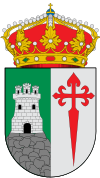Hornachos
| Hornachos, Spain | ||
|---|---|---|
 |
||
|
||
| Country | Spain | |
| Autonomous community | Extremadura | |
| Province | Badajoz | |
| Municipality | Hornachos | |
| Area | ||
| • Total | 296 km2 (114 sq mi) | |
| Elevation | 538 m (1,765 ft) | |
| Population (2005) | ||
| • Total | 3,840 | |
| • Density | 13.0/km2 (34/sq mi) | |
| Time zone | CET (UTC+1) | |
| • Summer (DST) | CEST (UTC+2) | |
Hornachos is a municipality located in the province of Badajoz, Extremadura, Spain. According to the 2005 census (INE), the municipality has a population of 3,840 inhabitants.
The first human settlements in the mountain range of Hornachos are dated from prehistoric times as shown by the cave paintings in the quartzite rocks. These paintings were made between the Neolithic and the Bronze Age, around 2,000-3,000 BCE.
The city was occupied during the Roman period and it was then when it received the name of Fornacis due to the iron mines and where the name 'Hornachos' ultimately derives. Archaeological evidence (Hornachuelos Oppidum) shows that the site had certain importance in Emerita Augusta during the 2nd and 1st centuries BCE. During the Visigoths' time the tradition sets Hornachos as the refugee of Saint Hermenegild when escaping from his father, King Leovigild.
The defensive fortress crowning the village was built during the Al-Andalus period. In 1234 Hornachos was occupied by the Order of Santiago, as a land grant by Ferdinand III of Castile, However, this was not originally a cause of concern for the majority Muslim -then Morisco after 1502- population. Nevertheless, at the end of the 16th century the village was surrounded by a wall and there were more than 10,000 inhabitants, being the most important Morisco centre in Spain. The Spanish captain Alonso de Contreras narrates in his memoir how he found a stash of arms stored by some Moriscos, and years later was accused of planning a revolt with said Moriscos. On April 9, 1609, King Philip III of Spain decreed the expulsion of the Moriscos. The village underwent a period of decline.
...
Wikipedia

